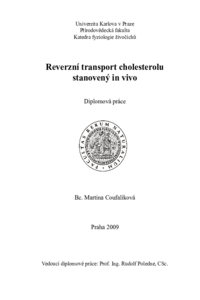Reverzní transport cholesterolu stanovený in vivo
Reverse cholesterol transport determine in vivo
diplomová práce (OBHÁJENO)

Zobrazit/
Trvalý odkaz
http://hdl.handle.net/20.500.11956/26532Identifikátory
SIS: 52524
Kolekce
- Kvalifikační práce [19614]
Autor
Vedoucí práce
Konzultant práce
Vybíral, Stanislav
Oponent práce
Svoboda, Petr
Fakulta / součást
Přírodovědecká fakulta
Obor
Fyziologie živočichů
Katedra / ústav / klinika
Katedra fyziol. živočichů a vývoj. biol. (zrušena)
Datum obhajoby
1. 6. 2009
Nakladatel
Univerzita Karlova, Přírodovědecká fakultaJazyk
Čeština
Známka
Výborně
Pražský hereditárně hypercholesterolemický (PHHC) potkan je kmen vysoce citlivý na dietní cholesterol. Práce se zabývá charakteristikou nascentních VLDL částic a zavedením metody měření reverzního transportu cholesterolu in vivo na potkanech. Charakteristika nascentních VLDL částic Produkce VLDL částic byla porovnána u potkanů PHHC a Wistar po podání dvou kontrolních a 1% cholesterolové diety po dobu 3 týdnů. VLDL částice byly izolovány ze séra získaného 2 hodiny po i.v. aplikaci Tritonu WR 1339. Podávání cholesterolu v dietě nemělo u potkanů Wistar vliv na cholesterolémii, zatímco u potkanů PHHC došlo k vzestupu hladiny cholesterolu o 45 %. Po podání Tritonu WR 1339 vzrostla hladina triglyceridů (TG) v séru několikanásobně následkem akumulace VLDL částic. U potkanů Wistar na cholesterolové dietě došlo k mírnému nárůstu cholesterolu ve VLDL částicích a u PHHC potkanů došlo k vysokému obohacení VLDL částic o cholesterol. U PHHC potkanů na cholesterolové dietě jsou v játrech tvořeny nascentní VLDL částice výrazně obohacené cholesterolem. Měření reverzního transportu cholesterolu in vivo Primární buněčná kultura makrofágů získaná peritoneální laváží byla inkubována 48 h 3H cholesterolem a intraperitoneálně aplikována potkanům Wistar a PHHC. U potkanů Wistar byla hladina 3H cholesterolu po 24 h vyšší než...
Prague hereditary hypercholesterolemic (PHHC) rat is a specie, which is very sensitive to a dietary cholesterol. Our study deals with characteristics of nascent VLDL particles and introduces new method for measurements of reverse cholesterol transport in vivo on rats. Characteristics of nascent VLDL particles Production of VLDL particles was studied with two different rat species - Wistar and PHHC. VLDL particles were isolated from a serum 2 hours after i.v. application of Triton WR 1339. No dependence of cholesteromie of the Wistar rats on the diet was observed, while increase of about 45 % of cholesterol of PHHC rats was found. The count of triglycerides (TG) after application of tyloxapol steeply increased as a result of accumulation of VLDL particles. Small increase of cholesterol in VLDL particles was observed assuming Wistar rats on the cholesterol diet, while the same increase was found to be rapidly higher with PHHC rats on the same diet. Liver of PHHC rats on the cholesterol diet therefore products nascent VLDL particles significantly enriched with cholesterol. Measurements of reverse cholesterol transport in vivo Primary cell culture of macrophages obtained by the help of peritoneal lavage was incubated for 48 hours with 3H cholesterol and then intraperitoneally applicated to Wistar and PHHC rats....
